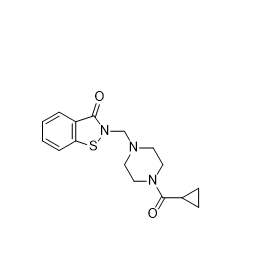| Cas No.: | 877963-94-5 |
| Chemical Name: | 2-[[4-(Cyclopropylcarbonyl)-1-piperazinyl]methyl]-1,2-benzisothiazol-3(2H)-one |
| Synonyms: | LOC 14;LOC14 |
| SMILES: | O=C1N(CN2CCN(C(C3CC3)=O)CC2)SC4=C1C=CC=C4 |
| Formula: | C16H19N3O2S |
| M.Wt: | 317.41 |
| Purity: | >98% |
| Sotrage: | 2 years -20°C Powder, 2 weeks 4°C in DMSO, 6 months -80°C in DMSO |
| Description: | LOC14 is a potent Protein disulfide isomerase (PDI) inhibitor with EC50 and Kd values of 500 nM and 62 nM, respectively. LOC14 exhibits high stability in mouse liver microsomes and blood plasma, low intrinsic microsome clearance, and low plasma-protein binding[1].LOC14 inhibits PDIA3 activity, decreases intramolecular disulfide bonds and subsequent oligomerization (maturation) of HA in lung epithelial cells[3]. |
| In Vivo: | LOC14 (orally administered by gavage; 20 mg/kg; once daily; 12-28 weeks) significantly improves motor function, attenuated brain atrophy and extended survival in the N171–82Q HD mice[2]. Animal Model: Male N171–82Q HD mice[2] Dosage: 20 mg/kg Administration: Orally administered by gavage; 20 mg/kg; once daily; 12-28 weeks Result: Improved motor function in HD mice. |
| In Vitro: | LOC14 (0.01-100 μM; 24 hours) exhibits the capacity to inhibit recombinant (r)PDIA3 at an IC50 of approximately 5 μM[3]. Cell Viability Assay[3] Cell Line: MTEC cells Concentration: 0.01 μM; 0.1 μM; 0.5 μM; 1 μM; 5 μM; 10 μM; 100 μM Incubation Time: 24 hours Result: Inhibited recombinant (r)PDIA3 activity. |
| References: | [1]. Kaplan A, et al. Small molecule-induced oxidation of protein disulfide isomerase is neuroprotective. Proc Natl Acad Sci U S A. 2015 Apr 28;112(17):E2245-52. [2]. Chamberlain N, et al. Lung epithelial protein disulfide isomerase A3 (PDIA3) plays an important role in influenza infection, inflammation, and airway mechanics. Redox Biol. 2019 Apr;22:101129. [3]. Zhou X, et al. Small molecule modulator of protein disulfide isomerase attenuates mutant huntingtin toxicity and inhibits endoplasmic reticulum stress in a mouse model of Huntington's disease. Hum Mol Genet. 2018 May 1;27(9):1545-1555. |

 To enhance service speed and avoid tariff delays, we've opened a US warehouse. All US orders ship directly from our US facility.
To enhance service speed and avoid tariff delays, we've opened a US warehouse. All US orders ship directly from our US facility.




















